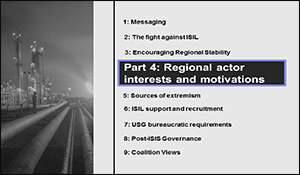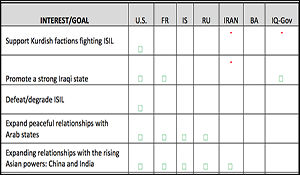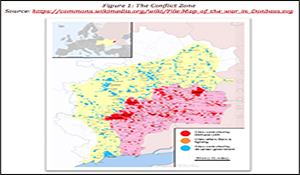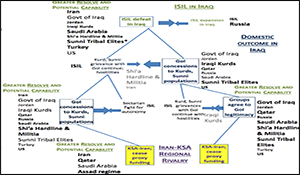Int’l Norms Transgressions Magnify Gray Zone Challenges
Violating Normal: How International Norms Transgressions Magnify Gray Zone Challenges. Author | Editor: Stevenson, J., Bragg, B., & Polansky (Pagano), S. (NSI, Inc.) Overview The current international system presents multiple potential challenges to US interests. In recent years, state actors, especially but not limited to Russia and China, have taken actions that disrupt regional stability […]
Continue ReadingUS and Russia Interests in Middle East
Question (R4.7): What are the respective national interests of the US and Russia in the Middle East, and what are the options for alleviating US/Russian tensions to mutual satisfaction and improved regional stability? Author | Editor: Polansky (Pagano), S. (NSI, Inc.). Executive Summary The geopolitical foundation of the Middle East is undergoing a fundamental shift […]
Continue Reading
Panel Discussion on the Gray Zone
Panel Discussion on the Gray Zone. Author | Editor: Popp, G., Canna, C., Bragg, B., Stevenson, J. & Kuznar, L. (NSI, Inc.). Overview At the request of the Commander, United States Special Operations Command (USSOCOM), the Strategic Multi-Layer Assessment (SMA) team initiated an effort, titled Gray Zone Conflicts-Challenges and Opportunities-A Multi-Agency Deep Dive Assessment, focused […]
Continue Reading
Part 4 Actor Interests and Motivations
SMA CENTCOM Reach-back Reports – Part 4: Regional Actor Interests and Motivations. Author | Editor: SMA Program Office. This is Part 4 of a 9 part series of SMA Reach back responses to questions posed by USCENTCOM. Each report contains responses to multiple questions grouped by theme. At the request of United States Central Command […]
Continue ReadingDiscourse Indicators of Gray Zone: Estonia
Discourse Indicators of Gray Zone Activity: Russian-Estonian Relations Case Study. Author | Editor: Dr. Lawrence Kuznar, George Popp, & Nicole (Peterson) Omundson (NSI, Inc.) The increasing use of emotive themes and rhetorical devices (that amplify a message’s emotional effect) provide indicators of gray zone activities in speeches made by Eurasian regional leaders and has the […]
Continue ReadingDiscourse Indicators of Gray Zone: Crimea
Discourse Indicators of Gray Zone Activity: Crimean Annexation Analysis Case Study. Author | Editor: Dr. Lawrence Kuznar, George Popp, & Nicole (Peterson) Omundson (NSI, Inc.) The increasing use of emotive themes and rhetorical devices (that amplify a message’s emotional effect) provide indicators of gray zone activities in speeches made by Eurasian regional leaders prior to […]
Continue Reading
Regional Interests Analysis
Question (S2): In light of their divergent goals and interests, what are the necessary factors that would permit the U.S.-led Coalition, regional stakeholders (including Israel, Russia, and Iran), or jihadist groups to achieve their aims in Iraq? Where do disparate groups’ interests align and where do they diverge? What can the U.S. coalition do to […]
Continue Reading
The Conflict in the Donbas between Gray and Black
The Conflict in the Donbas between Gray and Black: The Importance of Perspective. Author | Editor: Finkel, E. (University of Maryland, START). The current case study analyzes the presence and importance of Gray Zone conflict dynamics and the employment of various instruments of power during the still ongoing conflict in Eastern Ukraine (Donbas) since its […]
Continue Reading
Understand and Respond to Contemporary Russia
Finland, After ‘hybrid warfare’, what next? – Understanding and responding to contemporary Russia. Author | Editor: Bettina Renz ja Hanna Smith (Office of the Prime Minister of Finland). More than two years after Russia’s annexation of Crimea, the West continues coming to terms with the implications of this event. As discussed by the project’s the […]
Continue Reading
Part IV: Results of 5 of 8 Conflicts in Iraqi-Syria
Part IV: Analysis of the Dynamics of Near East Futures: Assessing Actor Interests, Resolve and Capability in 5 of the 8 Regional Conflicts. Author | Editor: Astorino-Coutois, A. (NSI, Inc). This briefing is the final part of a four-part study exploring the dynamics of the central Middle East conflict system. Part II describes the system […]
Continue Reading